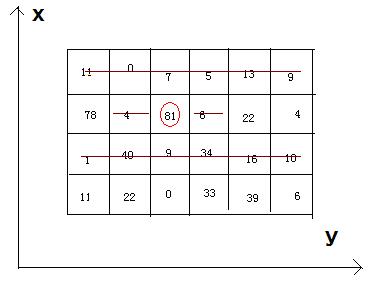吃土豆
时间限制:1000 ms | 内存限制:65535 KB
难度:4
- 描述
- Bean-eating is an interesting game, everyone owns an M*N matrix, which is filled with different qualities beans. Meantime, there is only one bean in any 1*1 grid. Now you want to eat the beans and collect the qualities, but everyone must obey by the following rules: if you eat the bean at the coordinate(x, y), you can’t eat the beans anyway at the coordinates listed (if exiting): (x, y-1), (x, y+1), and the both rows whose abscissas are x-1 and x+1.
Now, how much qualities can you eat and then get ?
- 输入
- There are a few cases. In each case, there are two integer M (row number) and N (column number). The next M lines each contain N integers, representing the qualities of the beans. We can make sure that the quality of bean isn't beyond 1000, and 1<=M,N<=500.
- 输出
- For each case, you just output the MAX qualities you can eat and then get.
- 样例输入
-
4 6 11 0 7 5 13 9 78 4 81 6 22 4 1 40 9 34 16 10 11 22 0 33 39 6
- 样例输出
-
242
-
//开始没考虑全面只考虑了一个dp,后来发现原来横着的最大和也是一个DP,题中用value[]数组来存放了………………
-
1 #include<iostream>
2 #include<memory.h>
3 using namespace std;
4 #define max(a,b) a>b?a:b
5 int dp[505], value[505];
6 int main()
7 {
8 // freopen("in.txt","r",stdin);
9 int m,n,i,j,x,y;
10 while(cin>>m>>n)
11 {
12 memset(dp,0,sizeof(dp));
13 memset(value,0,sizeof(value));
14 for(i = 0; i < m; ++i)
15 {
16 x = y = 0;
17 for(j = 0; j < n; ++j)
18 {
19 cin>>value[j];
20 if(j == 1) value[1] = max( value[0], value[1] );
21 if(j > 1)
22 value[j] = max( value[j-1], value[j] + value[j-2]);
23 }
24 dp[i] = value[n-1];
25 }
26 dp[1] = max(dp[0],dp[1]);
27 for(i = 2; i < m; ++i)
28 dp[i] = max( dp[i-1] ,dp[i] + dp[i-2]);
29 cout<<dp[m-1]<<endl;
30 }
31 return 0;
32 } -
